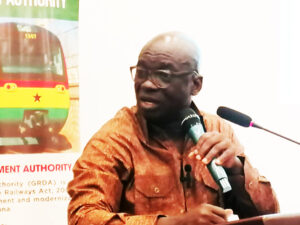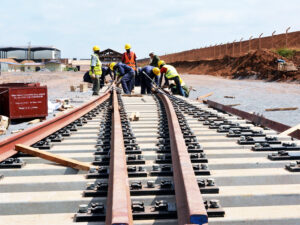The Chief Executive Officer (CEO) of the Ghana Railway Development Authority (GRDA), Yaw Owusu, has conceded that it will be a daunting task to construct 4000 kilometers of standard gauge railway network throughout the country, as contained in the revised 2020 Railway Master Plan.
“The ambitious goal is to construct 4000km of standard gauge railway lines across the country in the foreseeable future is a daunting task, but not impossible. Because a journey of thousand miles begins with the first step and it is not about big leaps but rather small steps,” he said.
Speaking at a day’s stakeholders sensitisation workshop on the new Railway Master Plan, the GRDA CEO pointed out that it has been proven throughout the world that the path to industrialisation goes through an efficient railway system and that the president vision to revamp the sector has all the hallmarks of industrialisation.

It takes an ambitious and visionary leader to embark on such a highly capital intensive infrastructural projects. There is no doubt that the economic headwinds currently facing the country has greatly impeded the progress of work.
Nonetheless, the newly constructed 97 kilometer Tema-Mpakadan railway line is near completion, the 80 kilometer railway line from Takoradi Port to Hunni-Valley will continue to Dunkwa, Awaso and Nyinahin to benefit manganese mines at Nsuta and the bauxite mines at Awaso and Nyinahin.
The six kilometer double line from Kaase to Adum in Kumasi is also ongoing. These lines, according to him, are standard gauge that comes with $1billion price tag.
The GRDA CEO, however, told the stakeholders that the short term objective of GRDA and for that matter the Ministry of Railway Development was to complete the Takoradi Port to the Nsuta Manganese Mines by the end of 2025, to augment production and transportation of manganese that would boost freight revenues for their sister operating company, GRCL.
The Takoradi port to Nsuta railway line, according to the CEO, is a section of the 500 million euro Takoradi Port to Hunni Valley project.
Currently, railway accounts for less than 1% of the transport sector and this narrative, according to CEO Yaw Owusu, has to change to make railway a strategic parity and not an auxiliary to boost intermodal transport system in the country.

The Deputy Minister for Railway Development, Kwaku Asante Boateng, on his part pointed out that the decision to revise the Railway Master Plan in 2020 was to connect all regional capitals to the railway network and connect all mineral deposit areas.
The Deputy Minister, who is also a Legislator, however, bemoaned the high cost of constructing and developing a kilometer of standard gauge railway line.
According to him, Ghana is currently constructing the standard gauge line at a cost of $5m per kilometer.
The government is envisaging constructing 4000 kilometers, meaning the state would have to ‘cough up’ a staggering $20 billion to realise the dreams of the master plan.
“If our dream is to come true, we will need $20b for the development of the Master Plan. If we are to develop at a cost of $5milion per a kilometer, you can guess when we will be able to achieve this plan,” he said.
He continued, “we cannot as a nation continue to be poor by going on this tangent by borrowing money to develop the sector. We know if we are able to develop the sector, there will be savings in transport cost and in terms of increasing GDP”.
He said from Manso to Hunni-Valley alone, constructing and developing the standard gauge line would cost $500million.
“We are constrained financially. We cannot on our own develop the railway sector at a minimal cost than we are doing.”
He conceded, “We will deceive ourselves that by 2035 we are finishing the Master Plan. By 2050, we will still be on one line. It’s a joke and we have to pause and rethink”.
On illegal mining, popularly known as ‘Galamsey’, the deputy Minister expressed grave worry over the devastating effect of the illegal activity on the standard gauge railway line.
According to him, his recent inspection of railway line in the region revealed that the Galamseyers were working 2 meters away from the standard gauge lines.
To him, the activity of the illegal miners posed a threat to the development of the lines, given that it weakens the foundation of the lines and this was worrying.
The Guest Speaker for the workshop, Nana Kobina Nketi V, Omanhene of Esikado Traditional Area, said if the development of the railway lines was going to bring back our nationalism, then government needed to do it.










